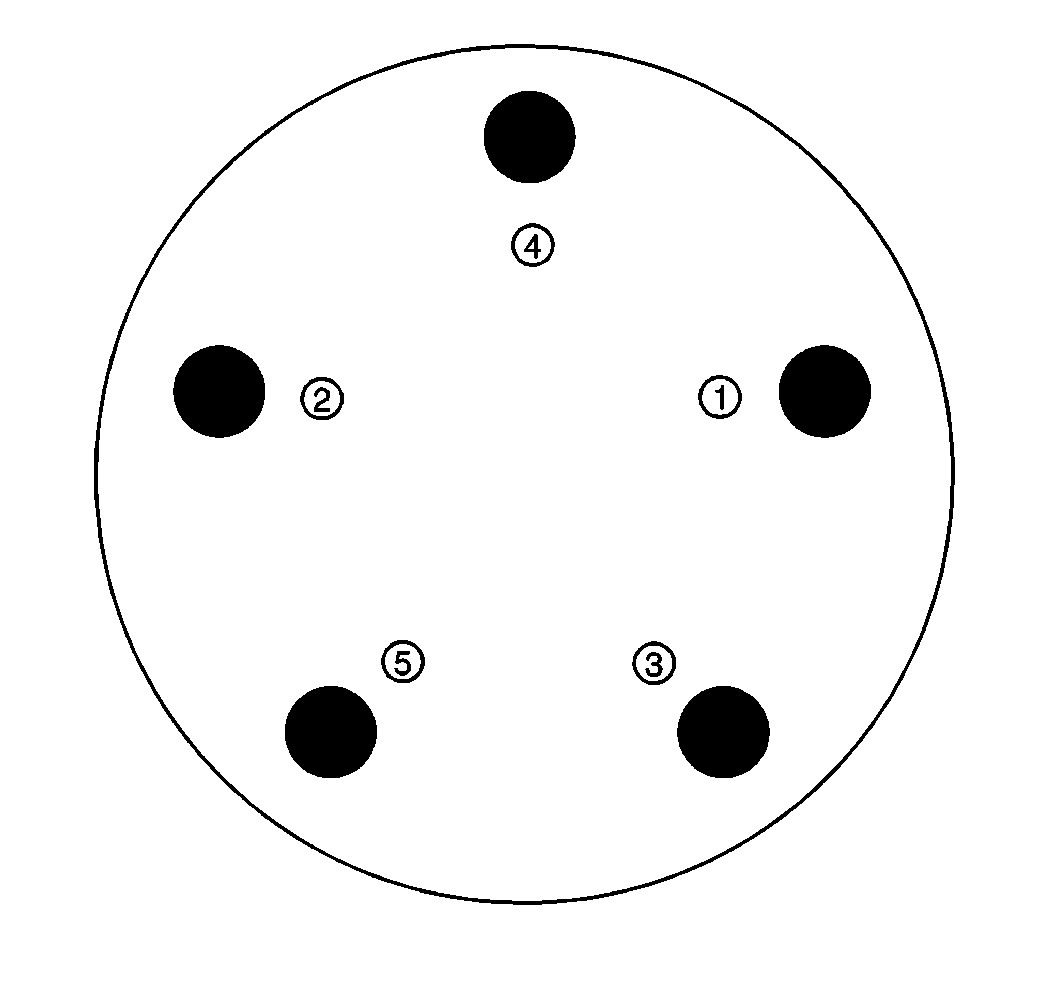Caution: If penetrating oil gets on the vertical surfaces between the wheel and the rotor or drum it could cause the wheel to work loose as the vehicle is driven, resulting in loss of control and an injury accident.
Notice: Never use heat to loosen a tight wheel. It can shorten the life of the wheel, studs, or hub and bearing assemblies. Wheel nuts must be tightened in sequence and to the specified torque to avoid bending the wheel or rotor.
Penetrating oil is not effective in removing tight wheels. However, if used, apply the penetrating oil sparingly to the hub surface only.
Excessive force, such as hammering the wheel or the tire, may cause damage. Lightly tap the tire's sidewall with a rubber mallet.
Sometimes wheels can be difficult to remove from the vehicle due to foreign material or a tight fit between the wheel center hole and the hub or rotor. Use the following procedure to safely remove the wheel:
- Tighten all of the wheel nuts on the affected wheel.
- Loosen each wheel nut two turns.
- Lower the vehicle onto the floor.
- Rock the vehicle from side to side as hard as possible using one or more person's body weight to loosen the wheel.
- Rock the vehicle from Drive gear to Reverse gear allowing the car to move several feet in each direction. Apply quick, hard jabs on the brake pedal in order to loosen the wheel.
Removal Procedure
- Raise the vehicle. Refer to Lifting and Jacking the Vehicle in General Information.
- Remove the hub cap. Refer to Wheel Hub Cap Replacement - Center .
- Remove the wheel nuts.
- Mark the location of the tire and wheel to the hub.
- Remove the tire and wheel assembly.
- Clean the following components:
Caution: Before installing the wheels, remove any buildup of corrosion on the wheel mounting surface and brake drum or disc mounting surface by scraping and wire brushing. Installing wheels with poor metal-to-metal contact at the mounting surfaces can cause wheel nuts to loosen. This can cause a wheel to come off when the vehicle is moving, causing loss of control and possibly personal injury.
| • | The wheel nuts |
| • | The studs |
| • | The wheel |
| • | The rotor/drum mounting surfaces |
Installation Procedure
Tools Required
| • | 0-300 N·m (0-200 lb ft) Torque Wrench |
| • | J 39544-KIT Wheel Nut Torque Adapters |
Caution: Before installing the wheels, remove any buildup of corrosion on the wheel mounting surface and brake drum or disc mounting surface by scraping and wire brushing. Installing wheels with poor metal-to-metal contact at the mounting surfaces can cause wheel nuts to loosen. This can cause a wheel to come off when the vehicle is moving, causing loss of control and possibly personal injury.
Notice: A torque wrench or J 39544 must be used to ensure that wheel nuts are tightened to specification. Never use lubricants or penetrating fluids on wheel stud, nuts, or mounting surfaces, as this can raise the actual torque on the nut without a corresponding torque reading on the torque wrench. Wheel nuts, studs, and mounting surfaces must be clean and dry. Failure to follow these instructions could result in wheel, nut, and/or stud damage.
- Install the wheel and the tire assembly in position on the hub/rotor. Loosely install the wheel nuts.
- Turn the wheel until one nut is at the top of the bolt circle (4). Tighten the top nut securely, but do not torque.
- Loosely tighten the remaining nuts in a criss/cross pattern in order to minimize runout.
- Install the center cap. Refer to Wheel Hub Cap Replacement - Center .

Notice: Refer to Fastener Notice in the Preface section.
Tighten
Tighten the nuts to 140 N·m (103 lb ft).
Tighten the nuts evenly, and tighten the nuts alternately in order to avoid excessive runout (1-5).
